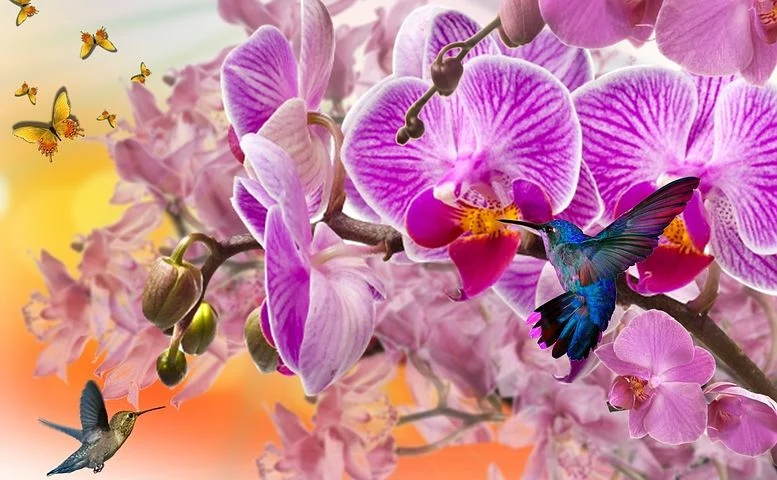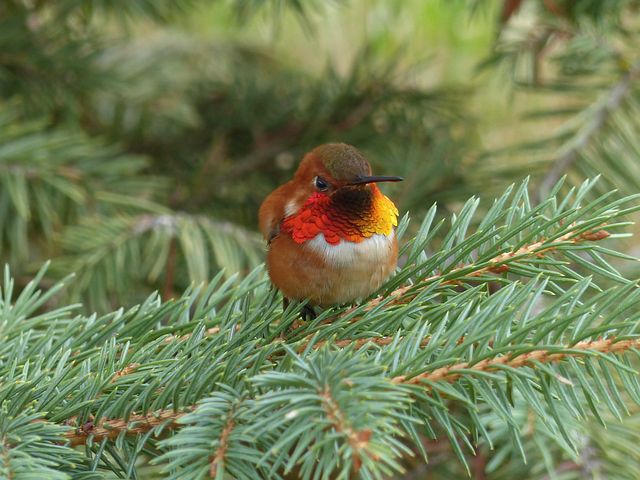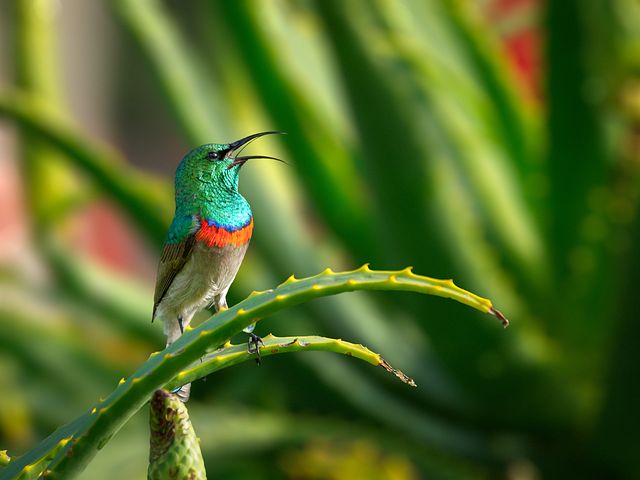Do hummingbirds change colors? This is a question that has puzzled people for years. Some people believe that they do, while others think that they do not.
In this blog post, we will whether hummingbirds change color in depth and try to answer this question once and for all!
Do Hummingbirds Change Colors?
Well, the answer to that question is yes! Hummingbirds do change color.
This is one of their unique physical characteristics as small birds with specialized wings for hovering, high-energy lifestyles for eating every ten minutes, and beautiful courtship dances to attract mates.
The color changes mainly take place around the head and chin of the hummingbird. It can be anywhere from a metallic green or purple to blue or bronze depending on where the hummingbird lives and which species it belongs to.
Can Hummingbirds Detect A Hummingbird Feeder By Its Color?
Studies have revealed that hummingbirds can indeed differentiate between multiple shades and tones of the same color, making them great candidates for detecting the perfect hue of a hummingbird feeder from far away.
While further research is needed to conclusively make this claim, the evidence so far suggests that hummers have an uncanny knack for finding the ideal feeder at just the right moment.
What Makes Hummingbirds Colorful?
Hummingbirds get their bold colors from a phenomenon known as structural coloration. This effect makes the birds look like they sparkle because their feathers refract light in unique ways.
Each feather contains numerous, very thin layers that reflect light at varying angles, helping to create all sorts of radiant hues from deep greens to iridescent purples and blues.
A mix of pigments in the feathers also further enhances their exceptional appearance.
What Colors Do Hummingbirds Have?
Hummingbirds come in an array of spectacular colors, from shimmering greens to eye-catching purples.
You may find iridescent blues, emeralds, and teals on the upper parts of their body that match beautifully with the vibrant turquoise found on their lower half.

Moreover, this colorful mosaic extends to their forked tails which can range from hot pinks to deep fuchsias. In addition to fascinating colors on the exterior, hummingbirds contain even more amazingly bright pigments located in their throats.
Depending on the species you observe, you may find shades of orange or yellow where throats meet chests – truly remarkable!
Hummingbird Feathers Flashing Around
Flashing hummingbird feathers are a dazzling sight to behold!
With colors ranging from brilliant blues and greens to rusty browns, these tiny birds flutter around like miniature blurs of color, delighting anyone lucky enough to witness their beauty.
Hummingbirds’ feathers contain melanin pigments just like our skin and eye color, allowing light reflection that gives the bird’s feathers their vivid colors.
Air Bubbles & Hummingbirds
Air bubbles represent an important, yet often overlooked, part of hummingbird aerodynamics.
When they spread their wings and flap them rapidly up and down, the air bubbles that are created beneath the wings help to reduce both drag and lift forces.

This allows hummingbirds to make more efficient use of the energy produced by their incredibly rapid wing movements for lift, rather than having all of it used for fighting against the resistance of still air.
Colorful Plumage of Hummingbirds – The Science Behind The Illusion of Shifting Colors
The vibrancy of hummingbirds’ plumage is truly a sight to behold. Beyond adding a visual sparkle to the garden, interesting science lies behind how hummingbird feathers create such vivid colors.
The magic of hue-shifting feathers comes from two phenomena: structural coloration and iridescence. Structural coloration occurs when incoming light is selectively reflected off the surface of tiny grooves or barbs in the feathers, creating either bright spots of intense color or prismatic hues across an entire feather.
Hummingbirds Of North America
North America is home to over 350 bird species of stunning hummingbirds, the smallest migratory birds in the world.
Hummingbirds exhibit a variety of behaviors including hovering and hanging in mid-air while they seek out nectar from flowers.
They have bright feathers, light hits, and are engulfed in bright colors.

They can also brave temperatures as low as -20° F, migrating many thousands of miles between breeding grounds in summer and warmer climates during winter.
Ruby-throated Hummingbird
The Ruby-throated Hummingbird (Archilochus colubris) is the most widespread hummingbird species in North America.
This beautiful bird has dark green feathers and can be spotted throughout eastern and central regions in North America, although they don’t travel further north than Canada.
Even though these small birds weigh much less than a penny, their long-distance travels are quite remarkable. Every year, these tiny wonders migrate south over 2,000 miles across the Gulf of Mexico to overwinter in Central America!
5 Stunning Hummingbird Species With Iridescent Feathers
There are more than 300 species of hummingbirds on earth, and many of these species boast breathtakingly beautiful iridescent feathers.
Not only do the feathers’ colors change depending on the viewing angle, but research has also shown that they can portray a total of seven distinct colors.
This vibrant display of colors is the result of the structure of light-interacting pigments in a layer underneath their tiny feathers. The formation of this particular type of feather has intrigued scientists for generations, leading them to study this phenomenon to get a better understanding of life itself. From its application in telecommunications to evolutionary biology, it’s safe to say that these iridescent hummingbird species have affected our world far larger than one might expect from such tiny creatures.
Anna’s Hummingbird
Anna’s Hummingbird is a small and vibrant bird native to western North America. These hummingbirds are easily recognizable by the males’ iridescent purple-red throat feathers.
They thrive in a variety of habitats, from Pacific coastline areas to urban gardens, giving them ample opportunity to feed on various types of nectar and insects.
Anna’s Hummingbirds have an impressive ability to hover in midair while feeding which they use to stay close to their favorite flowers.
Allen’s Hummingbird
Found mostly in western North America, Allen’s hummingbird is a vibrant and colorful bird known for its easy adaptability to new environments.
At less than four inches long, it features a brilliant greenback, greyish-white chest, and two bands of iridescent feathers. Growing up to 3 to 4 years of age, these birds feed on flower nectar and small insects.
Rufous Hummingbirds
The Rufous Hummingbird is an intrepid traveler with a fiery spirit.
Every year this species embarks on a remarkable journey from its summer habitat in Canada and Alaska to its winter grounds in Mexico and Central America. Along the way, it moves through diverse ecosystems as it forages for food and collects nectar when there are blooms.
It even manages to exhibit controlled hovering while sleeping—a fascinating task that few animals have mastered.
Costa’s Hummingbird
Costa’s hummingbird is a colorful creature with stunning iridescent feathers that come in shades of green and violet.
This species can be found mainly in the western coastal states of the United States, and they migrate south during the winter months. They have excellent flying ability and can hover in midair while looking for food such as nectar and small insects.
Fiery-throated Hummingbird
The fiery-throated hummingbird is a species of hummingbird that resides in North America.
It stands out for its iridescent throat feathers which glow with stunning oranges and reds, giving it an otherworldly presence. The fuzzy-bodied creatures can often be spotted flitting around coffee plantations, but they also inhabit tropical dry forests, moist montane forests, and even coffee shade trees.
They feed on nectar from flowering plants like heliconias and take frequent sips of mineral-rich mud along rivers or streams. These vibrant birds are true wonders to behold and it’s no surprise that they have been attracting the attention of birdwatchers alike.







